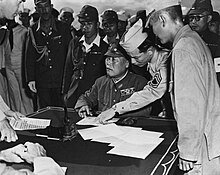Yoshio Tachibana
Yoshio Tachibana | |
|---|---|
 Lieutenant-General Yoshio Tachibana, Japanese Imperial Army, prepares to sign documents surrendering the Bonin Islands | |
| Born | February 24, 1890 Ehime prefecture, Japan |
| Died | September 24, 1946 (aged 56) Guam |
| Allegiance | Empire of Japan |
| Service | |
| Years of service | 1903 - 1945 |
| Rank | Lieutenant General |
| Commands | 1st Independent Mixed Brigade 109th Infantry Division |
| Battles / wars | World War II |
Template:Japanese name Yoshio Tachibana (立花 芳夫, Tachibana Yoshio, 24 February 1890 – 24 September 1946) was a lieutenant general of the Japanese Imperial Army. He was commander of the Japanese troops in Chichijima, Ogasawara Islands, and was held responsible for the “Chichijima Incident” a war crime involving torture, extrajudicial execution and cannibalism of Allied prisoners of war.
Biography
Tachibana was a native of Ehime prefecture. He graduated from the Imperial Japanese Army Academy in 1913, and had a relatively undistinguished early career. From 1924-1925 he was assigned to the Manchukuo Imperial Army as a liaison officer. In 1942, he was assigned to the staff of the Hiroshima regional defense command, and promoted to major general in March 1943. In May 1944, he became commander of the IJA 1st Independent Combined Brigade. He was further promoted to lieutenant general on March 23, 1945, and given command of the IJA 109th Division, which was tasked with the defense of the Bonin Islands against invasion by American forces in the preliminary preparations to Operation Downfall.
By mid-1945, due to the Allied naval blockade, Japanese troops on Chichijima had run low on supplies and were starving, so Tachibana's senior staff turned to cannibalism. In August 1944 [1] and February/March 1945 [2] in what came to be known later as the “Ogasawara Incident”, Tachibana, known to his staff as a sadistic, alcoholic commander, issued an order that all American prisoners of war (downed aviators) be killed.[3]
Two prisoners were beheaded in a public ceremony and per an account in Time Magazine, their livers were immediately cut from their bodies and served as sukiyaki .[4] It was not disputed that eight prisoners of war were executed, and some of the bodies were butchered by the division’s medical orderlies and portions were eaten by the senior staff of the Japanese garrison.
At the end of the war, Tachibana and his staff were arrested by the American occupation authorities and were deported to Guam, where they stood trial for war crimes in connection with the Ogasawara Incident in August 1946.[5] However, as cannibalism was not covered under international law at the time, Tachibana was charged with "prevention of honorable burial"[4] in addition to his execution of prisoners, and along with four other defendants, was sentenced to death by hanging.
See also
References
- Hearn, Chester (2005). Sorties Into Hell: The Hidden War on Chichi Jima. The Lyons Press. ISBN 1-59228-687-9.
- Maga, Timothy P. (2001). Judgment at Tokyo: The Japanese War Crimes Trials. University Press of Kentucky. ISBN 0-8131-2177-9.
External links
- Surrender of Bonin Islands, September 3, 1945
- Researching Japanese War Crimes - Introductory Essays (pp. 102-110). Nazi War Crimes and Japanese Imperial Government Records. Interagency Working Group, Washington DC, 2006.
Notes
- ^ [1]
- ^ list of POWs killed
- ^ Hearn, Sorties into Hell
- ^ a b Time, Unthinkable Crime, September 16, 1946.
- ^ Maga. Judgment at Tokyo
